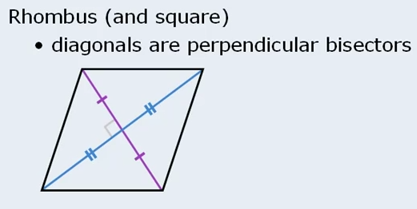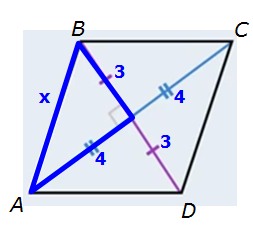In the rhombus ABCD, the length of diagonal BD is 6 and the length of diagonal AC is 8. What is the perimeter of ABCD?
a. 10
b. 14
c. 20
d. 24
e. 28
OA - c
Rhombus - MGMAT
This topic has expert replies
- beatthegmatinsept
- Master | Next Rank: 500 Posts
- Posts: 422
- Joined: Mon Aug 09, 2010 11:47 am
- Thanked: 22 times
- Followed by:1 members
- GMAT Score:680
We know that the two diagnols of a rhombus bisect each other and form a 90 degree angle at the intersection. So if you draw a rhombus with intersecting diagnols, you get 4 triangles. Since you know each diagnol is cut into half by the other diagnol, you have the 2 sides of the triangle. Using pyathorean theorum, calculate the hypotenuse using sides 3 and 4, you get 5.singhsa wrote:In the rhombus ABCD, the length of diagonal BD is 6 and the length of diagonal AC is 8. What is the perimeter of ABCD?
a. 10
b. 14
c. 20
d. 24
e. 28
OA - c
Perimeter = 4(5) = 20 (C)
Being defeated is often only a temporary condition. Giving up is what makes it permanent.
- Anaira Mitch
- Master | Next Rank: 500 Posts
- Posts: 235
- Joined: Wed Oct 26, 2016 9:21 pm
- Thanked: 3 times
- Followed by:5 members
A rhombus is a parallelogram with four sides of equal length. Thus, AB = BC = CD = DA.
The diagonals of a parallelogram bisect each other, meaning that AC and BD intersect at their midpoints, which we will call E. Thus, AE = EC = 4 and BE = ED = 3. Since ABCD is a rhombus, diagonals AC and BD are also perpendicular to each other.
Labeling the figure with the lengths above, we can see that the rhombus is divided by the diagonals into four right triangles, each of which has one side of length 3 and another side of length 4.
Remembering the common right triangle with side ratio = 3: 4: 5, we can infer that the unlabeled hypotenuse of each of the four triangles has length 5.
Thus, AB = BC = CD = DA = 5, and the perimeter of ABCD is 5 × 4 = 20.
The correct answer is C.
The diagonals of a parallelogram bisect each other, meaning that AC and BD intersect at their midpoints, which we will call E. Thus, AE = EC = 4 and BE = ED = 3. Since ABCD is a rhombus, diagonals AC and BD are also perpendicular to each other.
Labeling the figure with the lengths above, we can see that the rhombus is divided by the diagonals into four right triangles, each of which has one side of length 3 and another side of length 4.
Remembering the common right triangle with side ratio = 3: 4: 5, we can infer that the unlabeled hypotenuse of each of the four triangles has length 5.
Thus, AB = BC = CD = DA = 5, and the perimeter of ABCD is 5 × 4 = 20.
The correct answer is C.
GMAT/MBA Expert
- Brent@GMATPrepNow
- GMAT Instructor
- Posts: 16207
- Joined: Mon Dec 08, 2008 6:26 pm
- Location: Vancouver, BC
- Thanked: 5254 times
- Followed by:1268 members
- GMAT Score:770
In a rhombus, the diagonals are perpendicular bisectors.singhsa wrote:In the rhombus ABCD, the length of diagonal BD is 6 and the length of diagonal AC is 8. What is the perimeter of ABCD?
a. 10
b. 14
c. 20
d. 24
e. 28
OA - c

So, we can add our lengths as follows.

From here, if we focus on one of the 4 right triangles....

...we see we can apply the Pythagorean Theorem to write: 3² + 4² = x²
Evaluate: 9 + 16 = x²
So, 25 = x²
Solve to get: x = 5
Since all 4 sides of a rhombus have equal length, the perimeter = (4)(5) = 20
Answer: C
Cheers,
Brent




















